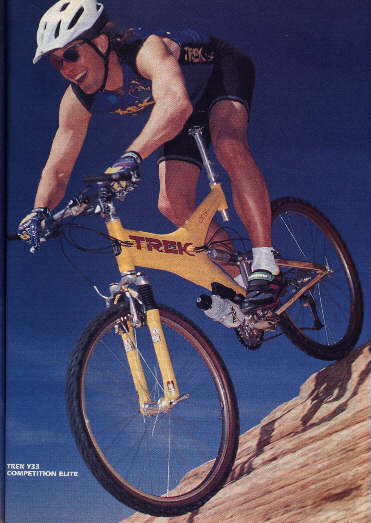
From July 1996 Popular Mechanics. The Trek Y33 was being compared against five other bikes and came out top.
During 1995 Trek released a bike design
that would revolutionise the design of mountain bikes for several years.
It was called the Y33, and was made from what Trek called OCLV, or Optimum
Compaction Low Void. In plain English, that's Carbon Fibre. This would
have been one of the most expensive top of the range mountain bikes then
available. The revolutionary aspect of design was the Y frame with a URT
(Unified Rear Triangle), which was the ultimate in simplicity for a full
suspension design.
It also won an industrial design award.
It wasn't long before everyone else was
copying it, though usually with only a two piece "Y" or variants thereof,
and differing pivot points for the URT. There was some mention of Trek
attempting to seek compensation from GT for infringing their patent.
So, next time you see a Y frame bike, remember it came from Trek's Y33.

From July 1996 Popular Mechanics. The Trek Y33 was being compared
against five other bikes and came out top.
Trek didn't stop with the Y33 for there
was a whole series of Y frame OCLV bikes and to make the Y design more
affordable to the masses, a series of aluminium models were released.
The last of Trek's Y frame mountain bikes
were released in 2001.
The OCLV Frames
These were produced from 1995 to 1999
but developed a reputation for problems with the initial models. The main
one was the rear shock mount would become detached; it was only glued on
to the frame. There were also a few incidents with the carbon fibres delaminating.
Some riders complained of the frame being noisy; apparently the hollow
carbon fibre frame had some sort of amplifying effect. These problems
were overcome for the 1998-1999 models, with a change of frame design.
The improved Y series carbon fibre frames look more like a wedge shape
than a Y, and the rear shock mount is much stronger; being moulded into
the frame itself.
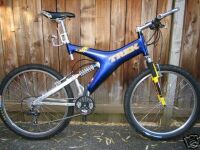
1997 Y11 in large size. The "Y11" is a two tone yellow/black
decal on the upper arm near the seat tube.
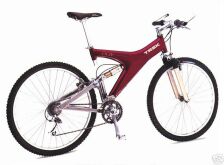
1995 medium Y22. The most popular of the OCLV Y bikes. 1996 saw
a nude carbon finish while for 1997 it version was available in cream with
the "Y22" decal being two tone red/black.
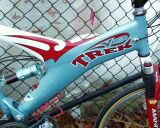
1997 Y50 (Y Five O) in large size...named after the "Hawaii Five
O" TV series. Top of the range for 1997. Note the unusual body graphics.
The models in the initial OCLV Y frame
series were the Y50 (pronounced Y Five-0),Y33, Y22, and Y11. The Y33 was
intially the top of the range bike, but was overtaken by the Y50 in 1997.
All these models used the same frame and differed only in the body graphics
and components fitted. The Y50 did not appear with the new frame
in 1998. Instead, the "Y Superlite", YSL200, and YSL300 took its place,
and were then the top of the range. The URT for all these models was 6061
aluminium. The 1995-1997 URT's are made of rectangular section tubing,
with a replaceable derailleur hanger for the 1997 models. With the new
frame in 1998, the URT was now made of oval section tubing, also with a
replaceable derailleur hanger. The URT's are interchangeable and some of
the new style frames were fitted with the older URT's. Note that the Gary
Fisher Joshua uses the same URT. Hardly suprising, since Gary Fisher is
owned by Trek.
Trek also created a road bike at the time
called the "Y Foil". This had no suspension and looks nothing like the
mountain bikes. Its production was short as it was banned from competition
for being too light. One of the Tour de France commentators mentioned that
the bikes had to be a minimum weight of 6.8kg.
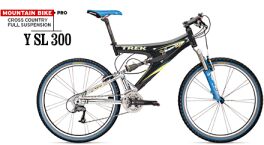
The new style OCLV frame introduced in 1998. Applicable to Y11,
Y22, Y33, YSL, YSL200 and YSL300. It eliminated rear shock mount failure.
The YSL's were made of OCLV-HC (Honeycomb) construction reducing weight
by 10%. The YSL300 pictured is a medium size 1999 model.
The Aluminium Y Frames
While the OCLV framed Y bikes had been
in production since 1995, the aluminium models came later. Initial attempts
to create an alloy Y bike resulted in the ST120 which uses the same URT
as the OCLV bikes.
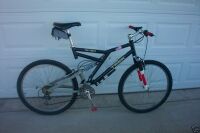
1996 large size ST120 has the same URT as the OCLV and later
aluminium Y bikes. The 1996 catalog states that, "Our new ST120 incorporates
all the functional advantages of our Y-bikes into an Easton aluminum design
at a shockingly low price."
It existed until 1997 when the true Y bikes;
the Y5 and Y3, and later Y1 and Y-Glide/ Y-Glide Deluxe came into existance.
For these bikes, the frames were identical throughout their production.
The main part of the frame (the Y shaped part) is made of 6061 Aluminium.
The Y5 and Y-Glide/Y-Glide Deluxe have their URT made from the same material,
and used the same URT's as the OCLV bikes. For the Y1 and Y3's, their URT
is chromoly and are made from round section tubing. The chromoly and alloy
URT's are therefore interchangeable, but of course the chromoly URT is
heavier (and stronger if you're into rough treatment). The Y5 weighs 12.7kg
and the Y3 is 13.2kg. As before, it's the quality of components that determine
the model, with the Y1 being the cheapest. Gripshift gear shifters were
used on some models at various times, but mostly various forms of Shimano
Rapid Fire shifters were used. V brakes were standard except for the Y
Glide Deluxe which was factory fitted with disc brakes. Cantilever brakes
were used on the 1995 OCLV models.
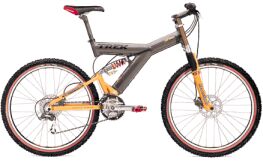
1998 Y Glide Deluxe. Note the disc brakes.
Radical New Design
Although it was seen as a radical new
design that got people's attention, the Y frame concept was not seen favourably
by some. The problem was bio pacing, otherwise known as the "pogo stick"
effect or "pedal bob", which has been a contentious issue with dual suspension
bikes since day one. Basically, the rear suspension caused loss of
power, particularly riding up hill. As the rider pedalled, the URT would
be moving up and down relative to the mainframe, using valuable energy.
The main reason for this is that the distance between the rider and the
pedals varies with frame movement.
Most of the manufacturers who were using
the design experimented with pivot point location to compromise between
rider comfort and bio pacing. Usually, this was done by moving the
pivot point, and also GT's I Drive system which used a unique bottom bracket
design. Some rear suspension designs (eg. Trek 9300) were very bad in that
the chain length would vary as the URT moved. With these bikes, the bottom
bracket is on the main part of the frame and not the URT.
Trek claimed to have found the ideal pivot
point and patented their design. This is why you won't see other bikes
with the pivot point part way up the URT.
Many gave up trying to perfect rear suspension
designs, feeling that if they couldn't make it work the best thing was
to eliminate it altogether. Thus, the creation of the hardtail. Strange
logic really...you wouldn't buy a car without rear suspension would you?
There is an ever so simple solution however, which Trek applied to the
top of the range models. These had lockout shocks to completely eliminate
the problem. However, if the rider is out of the saddle whilst pedalling,
without a lockout shock, the problem is again eliminated. The critics don't
really have any valid complaints.
The critics would also be hard pressed
to give examples of bikes lighter than the Y series. How many alloy dual
suspension bikes are lighter than the 12.7kg of a Y5? The OCLV models are
even better at just on 11kg for the Y50. Even the relatively heavy Y3 is
still lighter than many dual suspension bikes of today.
Something you won't find on other bikes
is the welder's initials stamped into the bottom bracket...further illustration
of Trek's pride in what they built.
The last of the real Trek Y bikes came
out in 2001 with the Y1 finishing up fitted with cheap components.
Trek kept the "Y" name going for a while
after, with the much cheaper bikes, the Y26 and Y24. These are not
in the same league as their predecessors and bear little resemblance to
the original bikes in quality and appearance, and are known as "entry level"
bikes. Although they continued with URT rear suspension, the URT's are
not the same.
Trek Y Bike Chronology - How to Date Your Y bike
1995: Y33 and Y22 OCLV models with cantilever brakes. Y33 was Indigo Blue and Y22 Ice Red
1996:
Y33 in now Judy Yellow, (i.e. frame colour matched to the Judy SL forks).
Y22 fitted with V brakes and now nude carbon. Y11 released in Dry
Ice Blue. Alloy ST120 released.
1997:
Y33, Y22, Y11 now have the "Yxx" logo on the upper arm of the frame printed
on a two tone decal. Y33 is Nude Carbon, Y22 is Gloss Cream and Y11 is
Gloss Ice Inkwell. Y50 takes over as top of the range OCLV with its unique
red/white/blue graphics. ST120 replaced by Y5 in polished aluminium
with black URT. Y3 introduced as a cheaper version of the Y5. It
had a red frame with white chromoly URT. Alloy URT's now have replaceable
derailleur hangers. Later versions of the Y50 are nude carbon.
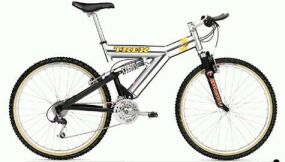
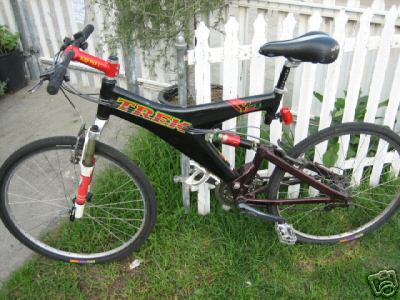
This version of the Y50 appeared later in 1997 and closely resembles
the Y33 of the same year. It is not shown in the catalog. This one
is a large frame.
1998:
This was definitely the year of the Y bike! The OCLV frame shape is changed
with a more rugged rear shock mount. This years OCLV models are a Y33 in
Platinum Pearl, Y22 in Blaze Red, and the Y11 in Team Yellow.
The alloy bikes
are the Y Glide Deluxe in Black Mercury Pearl, Y Glide in Ice Inkwell,
Y5 in Team Purple and the Y3 in Ice RC Blue. There is no longer a Y50.
Although they do not appear in the catalog, it appears that the Y Superlite
(24spd), and possibly the Y Superlite 200 (27spd) are introduced later
in the year. Other versions of the 1998 Y bikes which did not make the
catalog included a yellow Y33, a nude carbon Y33, and a blue Y22.
The alloy URT's
are now using oval section tubing and begin to feature disc brake mounts.
Y Glide and its disc brake counterpart, the Y Glide Deluxe are now the
top of the range alloy models. "Trek" decals are now 3D except the
YSL and YSL200.

1999: The decline of the Y bike is now imminent with only the YSL300, YSL200, and Y3. 3D decals are dropped on all models. The Y3 has lesser quality components compared to the previous year. The YSL300 is now top of the range. It and the YSL200 are using OCLVHC frames; 10% lighter than the standard OCLV.
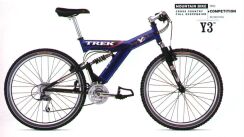
2000: Y1 is a cheap version of the Y3 introduced this year. It has lesser quality components. Y3 also remains.
2001: Y1 is the last of the Y bikes.

Y1 was fitted with relatively low grade components.

From the 1999 Catalog.
Note that the OCLV and aluminium frames have the same dimensions despite the different appearance. Get the size wrong and you end up with knee pain. Get the reach (C) wrong and you'll have neck and shoulder pain. It is interesting to note the seat angle (B). Is this the actual angle of the URT or is it the chainstay (D) relative to the seat? If the former, then it indicates that there are 3 variations of URT. I find it hard to imagine that one degree is going to make a signifigant difference. Interestingly, prior to 1999 the URT's are all the same size and have the same seat angle. When I queried buying a replacement URT for my Y22 I wasn't asked what size I needed either. And I don't believe the 3rd party Boulton URT came in S,M & L sizes.
What are the
actual sizes?
The only time Trek
actually list the frame size in the catalog is in 1995.
S=16"
M=18"
L=20"
Some of the early
bikes had a size sticker on the frame also with the measurement. From 1996
onwards, the bikes were simply listed as S,M, or L, although the size stickers
continued on the actual frame for a short time.
Note that the above
Trek measurement is from the crank centre to the top of the top tube. Most
people measure from crank centre to top of the seat post clamp, so the
above sizes are then slightly larger. Trek must have realised this, for
in the 1997 Retail Technical Manual they have changed their method of measuring
to the top of the seat post clamp, which they call "seat tube length".
Now the sizes are:
S=17.5"
M=19.5"
L=21.5"
From time to time there are supposed "XL" size bikes for sale. These are just ordinary large size with a longer stem fitted.
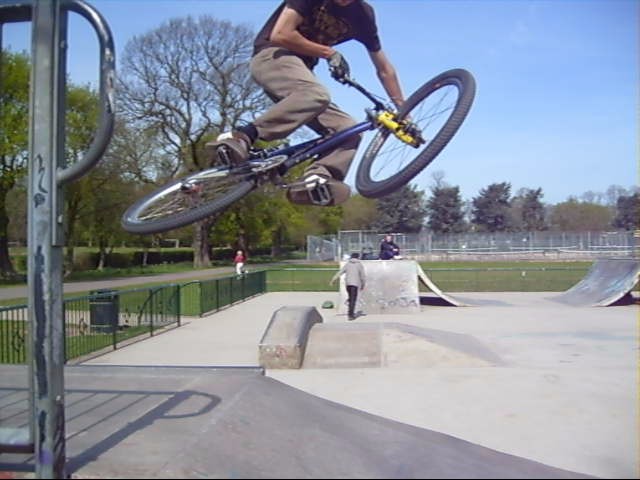
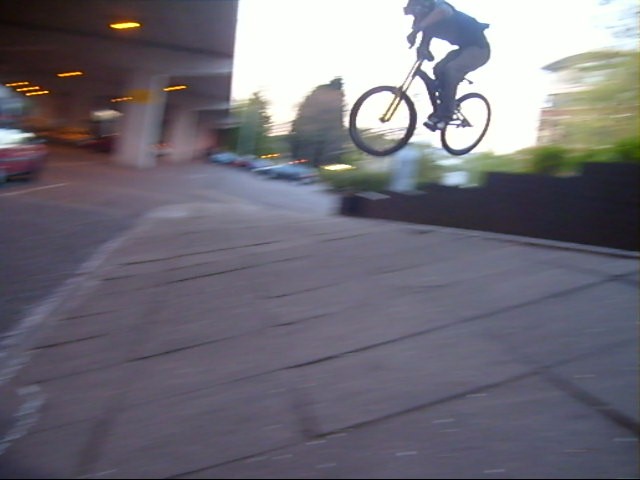
These pics came from Brian Sutherland in the UK who owns this 1995 Y11. It has been converted to single speed and has other components replaced. As can be clearly seen, it is being used as a BMX bike in these pics. It's obvious that the Y frame is not a weak design! Note also that this is the early OCLV frame, which is supposedly the weakest.
1997 Trek Y5. My first Y bike. Top of the range alloy model.
1999 Trek YSL200. The third Y bike to enter my collection. This was top of the range for 1999.
1998 Trek Y33. The fourth Y bike was this 1998 model. It looked nice so I had to have it.
1996 Trek Y33. The fifth bike to join the collection, but the first I've had in medium size and with the early style OCLV frame.
1995 Trek Y22. The sixth Y bike I've bought. Classic original Y bike technology on what is the earliest model.
1998 Trek Y11. My seventh Y bike..
1999 Trek Y3. Medium grade alloy model were my final two Y bikes.
(The 2nd bike was a lemon and I sold it).